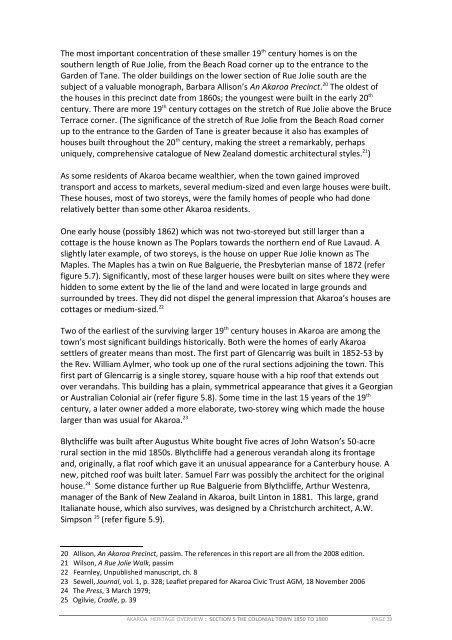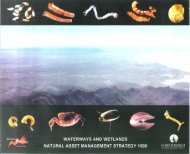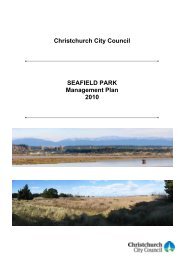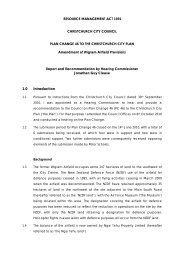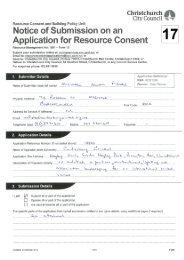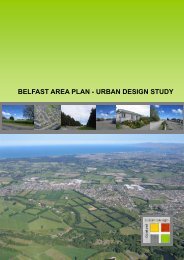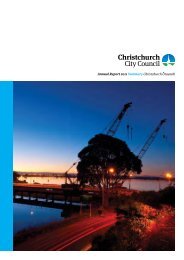Akaroa Historical Overview - Christchurch City Council
Akaroa Historical Overview - Christchurch City Council
Akaroa Historical Overview - Christchurch City Council
You also want an ePaper? Increase the reach of your titles
YUMPU automatically turns print PDFs into web optimized ePapers that Google loves.
The most important concentration of these smaller 19 th century homes is on the<br />
southern length of Rue Jolie, from the Beach Road corner up to the entrance to the<br />
Garden of Tane. The older buildings on the lower section of Rue Jolie south are the<br />
subject of a valuable monograph, Barbara Allison’s An <strong>Akaroa</strong> Precinct. 20 The oldest of<br />
the houses in this precinct date from 1860s; the youngest were built in the early 20 th<br />
century. There are more 19 th century cottages on the stretch of Rue Jolie above the Bruce<br />
Terrace corner. (The significance of the stretch of Rue Jolie from the Beach Road corner<br />
up to the entrance to the Garden of Tane is greater because it also has examples of<br />
houses built throughout the 20 th century, making the street a remarkably, perhaps<br />
uniquely, comprehensive catalogue of New Zealand domestic architectural styles. 21 )<br />
As some residents of <strong>Akaroa</strong> became wealthier, when the town gained improved<br />
transport and access to markets, several medium-sized and even large houses were built.<br />
These houses, most of two storeys, were the family homes of people who had done<br />
relatively better than some other <strong>Akaroa</strong> residents.<br />
One early house (possibly 1862) which was not two-storeyed but still larger than a<br />
cottage is the house known as The Poplars towards the northern end of Rue Lavaud. A<br />
slightly later example, of two storeys, is the house on upper Rue Jolie known as The<br />
Maples. The Maples has a twin on Rue Balguerie, the Presbyterian manse of 1872 (refer<br />
figure 5.7). Significantly, most of these larger houses were built on sites where they were<br />
hidden to some extent by the lie of the land and were located in large grounds and<br />
surrounded by trees. They did not dispel the general impression that <strong>Akaroa</strong>’s houses are<br />
cottages or medium-sized. 22<br />
Two of the earliest of the surviving larger 19 th century houses in <strong>Akaroa</strong> are among the<br />
town’s most significant buildings historically. Both were the homes of early <strong>Akaroa</strong><br />
settlers of greater means than most. The first part of Glencarrig was built in 1852-53 by<br />
the Rev. William Aylmer, who took up one of the rural sections adjoining the town. This<br />
first part of Glencarrig is a single storey, square house with a hip roof that extends out<br />
over verandahs. This building has a plain, symmetrical appearance that gives it a Georgian<br />
or Australian Colonial air (refer figure 5.8). Some time in the last 15 years of the 19 th<br />
century, a later owner added a more elaborate, two-storey wing which made the house<br />
larger than was usual for <strong>Akaroa</strong>. 23<br />
Blythcliffe was built after Augustus White bought five acres of John Watson’s 50-acre<br />
rural section in the mid 1850s. Blythcliffe had a generous verandah along its frontage<br />
and, originally, a flat roof which gave it an unusual appearance for a Canterbury house. A<br />
new, pitched roof was built later. Samuel Farr was possibly the architect for the original<br />
house. 24 Some distance further up Rue Balguerie from Blythcliffe, Arthur Westenra,<br />
manager of the Bank of New Zealand in <strong>Akaroa</strong>, built Linton in 1881. This large, grand<br />
Italianate house, which also survives, was designed by a <strong>Christchurch</strong> architect, A.W.<br />
Simpson 25 (refer figure 5.9).<br />
20 Allison, An <strong>Akaroa</strong> Precinct, passim. The references in this report are all from the 2008 edition.<br />
21 Wilson, A Rue Jolie Walk, passim<br />
22 Fearnley, Unpublished manuscript, ch. 8<br />
23 Sewell, Journal, vol. 1, p. 328; Leaflet prepared for <strong>Akaroa</strong> Civic Trust AGM, 18 November 2006<br />
24 The Press, 3 March 1979;<br />
25 Ogilvie, Cradle, p. 39<br />
AKAROA HERITAGE OVERVIEW : SECTION 5 THE COLONIAL TOWN 1850 TO 1900 PAGE 39


